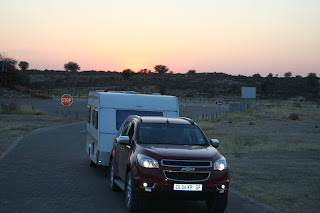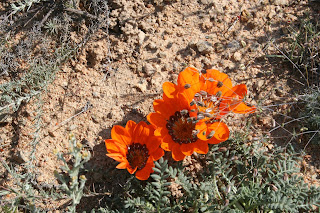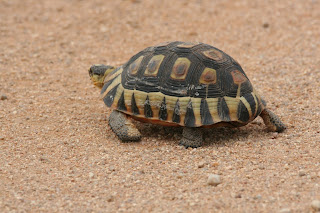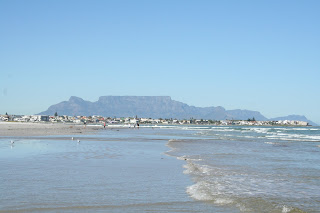September 2016
Johannesburg, Kgalagadi, Goegap Nature Reserve, Clanwilliam, Cape Town,
Victoria Bay, Karoo National Park, River Destiny Lodge
and back to Johannesburg
=================================================================
We had decided to originally take my remaining 2 weeks leave from IBM in September, but then IBM threw a curved ball and retrenched me. So, we amended our plans and took a few extra days in Cape Town and added in a few days at the Kgalagadi park. The round trip as per the map below.
This time we were travelling with the Chevrolet Trailblazer and our trusted Jurgens Avion L caravan.
Our first stop was to be a lodge in Upington. This was a total of 761 Km's for this first leg of the trip. So we made a early start as we wanted to have some time relaxing near the Orange River in Upington.
The trip takes us past Sannieshof and Kathu.
In Sannieshof we stopped off at a small butchery, because we have previously found that the butcher sold some really great spices. So we bought 2 different types from him.
Then we progressed onto Upington and to our accommodation for the evening. This I had booked over the internet and it looked good in the pictures and the reviews.
On arrival, the staff were very friendly and we were shown to our own private little chalet. Actually it was rather big. Two bedrooms, lounge, kitchen, bathroom with bath and full shower. The chalet looked out over the Orange river and green grass. It was perfect. The accommodation that I had booked was fantastic and we really enjoyed the few hours of sunlight there.
The trip up to the park was only 253km's. So we enjoyed a leisurely buffet breakfast which was most enjoyable and took a slow drive up thereafter.
The R360 is now a lovely tarred road. This tar road continued all the way to the gate of the park. Along the way there are numerous salt pans, some of which are being mined for their salt.
This is one of the many pans that you find along the road fro Upington to the park.
Just before the turn off to the park, you come across a small town called Askham. This is a little off the road (400m) and the access road is really terribly corrugated. We decided to go into the village to see what was on offer. We found a really nice coffee and gift shop (Padstal I suppose).
We enjoyed a drink there.
We arrived at the Kgalagadi round about midday.
So, after checking in, we parked the caravan under some trees near the chalet. We had decided not to camp and had booked one of the SanParks chalets. Good choice !
The braai facilities for each chalet are quiet a way from the chalet, for some strange reason. But n on the less we enjoyed a few braai's in the evenings.
We did see a large selection of animals, and here are a few :
Gemsbok.
https://en.wikipedia.org/wiki/Gemsbok
The gemsbok or gemsbuck (Oryx gazella) is a large antelope in the Oryx genus. It is native to the arid regions ofSouthern Africa, such as the Kalahari Desert.
Springbok
https://en.wikipedia.org/wiki/Springbok
The springbok /ˈsprɪŋˌbɒk/ (Antidorcas marsupialis) is a medium-sized antelope found mainly in southern and southwestern Africa. The sole member of the genus Antidorcas, this bovid was first described by the German zoologist Eberhard August Wilhelm von Zimmermann in 1780
-
Lion :
http://www.tswalu.com/media/blog-article/the-black-maned-kalahari-lions
The Kalahari lions are known for their majestic size and beautiful manes, although they are actually the same species as other lions found across Africa.
Giraffe :
https://en.wikipedia.org/wiki/Giraffe
The giraffe (Giraffa) is a genus of African even-toed ungulate mammals, the tallest living terrestrial animals and the largestruminants. The giraffe's chief distinguishing characteristics are its extremely long neck and legs, its horn-like ossicones, and its distinctive coat patterns.
Birds of prey :
There were so many birds of prey on this trip. We find it difficult to identify these, even using binoculars, Sasol Bird book and Sasol bird app. None the less, they were impressive.
Kori Bustard :
https://en.wikipedia.org/wiki/Kori_bustard
he kori bustard (Ardeotis kori) is the largest flying bird native to Africa. It is a member of the bustard family, which all belong to the order Gruiformes and are restricted in distribution to the Old World. It is one of the four species (ranging from Africa to India to Australia) in the large-bodied Ardeotis genus. In fact, the male kori bustard may be the heaviest living animal capable of flight.
Secretary Bird :
https://en.wikipedia.org/wiki/Secretarybird
The secretary bird or secretary bird (Sagittarius serpentarius) is a very large, mostly terrestrial bird of prey. Endemicto Africa, it is usually found in the open grasslands and savannah of the sub-Saharan region. Although a member of the order Accipitriformes, which also includes many other diurnal raptors such as kites, hawks, vultures, and harriers, it is given its own family, Sagittariidae.
Other Birds and animals seen :
We decided to take the Leeudril 4x4 drive over the dunes. This drive is not very challenging but there are some soft sand dunes that you need to navigate. Some have been known to be stuck on these for a few hours. But the Trailblazer cruised through them all.
It was amazing how much grass there was in the Kalahari, this time.
The picnic spots in the park are very good. Some are relatively far apart, but they have flush toilets and water. There are also tables and chairs which are strategically laced under some of the trees, to try and provide shade. We stopped off at a few of them, sometimes for a cold drink out of the Mobicool fridge and others for a bite of lunch.
They are currently working on revamping the petrol station at the camp. So there was only diesel there (lucky for me) and no petrol at all. I had to fill up at the temporary fuel depot.
When travelling on the corrugated roads, its recommended and advisable (by Sanparks officials) to drop the tyre pressure to 1.6 bar. I dropped mine to 1.5 bar and it really made a huge difference. They have a deflate and compressor at the fuel pump as well, so no problems pumping the tyres back up again.
Soon, it was time to leave the park and continue on our travels. Because we had 628 km's to travel, we left as the gates opened.
We traveled back to Upington and then continued along the N14 and traveled the 628Km's to Goegap Nature Reserve (just outside Springbok). passing through, Keimoes, Kakamas, Pofadder, Aggeneys and Springbok.
The Nature Reserve is roughly 10Km's outside of Springbok.
Our campsite at Goegap. It was lovely, as it was on the edge of the camping area and looked out over the "bush".
https://www.sanparks.org/parks/namaqua/
It is truly an amazing experience and site. We had decided that we would also travel to the Namaqua National Park, and in particular the Sklipad area. This is normally where the abundance of wild flowers are seen.
This year (2016) the flowers were not as good as they were during our last visit 3 years ago. But they were still amazing !
We left Goegap and our next destination was a caravan park near Clanwilliam.
We travelled through Kamieskroon, Garies, Ventersdorp and Klawer. We had booked at the Rondeberg resort which is conveniently situated just off the N7 Cape Town Namibia Route, 22 km north of Clanwilliam, on the banks of the Bulshoek Dam. I had booked a private ablution campsite. It looked superb.
We travelled through Kamieskroon, Garies, Ventersdorp and Klawer. We had booked at the Rondeberg resort which is conveniently situated just off the N7 Cape Town Namibia Route, 22 km north of Clanwilliam, on the banks of the Bulshoek Dam. I had booked a private ablution campsite. It looked superb.
So we decided to do a a round trip from Clanwilliam to Paternoster.
Paternoster is one of the oldest fishing villages on the West Coast of South Africa. It is situated 15 km north-west of Vredenburg and 145 km north of Cape Town, at Cape Columbine between Saldanha Bay and St Helena Bay.
We had lunch at a beach restaurant just inside the Cape Columbine park. It was really wonderful.
.
We stopped off at a small curio shop in the village, as well.
Some people might appreciate this, if you enjoy rugby and support "province"
We also visited Lambers Bay and the bird island reserve to see the Cape Gannet. There is an information center and visitors look out where a very helpful and extremely knowledgeable official is at hand to explain the coming and going of these birds.
Bird Island lies about 100m off the shore of Lambert’s Bay on the Cape’s West Coast. It offers visitors a rare opportunity to see the blue-eyed Cape gannet up close. Bird Island is one of only six sites world-wide where Cape gannets breed, and it is the only breeding site easily accessible to the public.
http://www.capenature.co.za/reserves/bird-island-nature-reserve/
We also had some lunch at a lovely restaurant at the harbor.
Whilst in Clanwilliam we also decided to take a drive up the Pakhuis pass. This is an amazing pass and the scenery was fantastic.
http://mountainpassessouthafrica.co.za/find-a-pass/western-cape/item/52-pakhuis-pass,-cederberg.html
Our next camp was at Melkbosstrand, near Cape town.
From Clanwilliam we continued along the N7 all the way to Melkbosstrand. This is where we were to stay at the Ou Skip Caravan Resort. It was a total of 284km's and a very pleasant drive. Melkbosstrand is on the west coast and just about 30km's from Cape Town. You get a superb view of Table Mountain from the beach.
From Clanwilliam we continued along the N7 all the way to Melkbosstrand. This is where we were to stay at the Ou Skip Caravan Resort. It was a total of 284km's and a very pleasant drive. Melkbosstrand is on the west coast and just about 30km's from Cape Town. You get a superb view of Table Mountain from the beach.
.
Whilst in Cape Town we decided to just, basically, take it easy and relax. WE did a few of the drives around and also went up to the West Coast National Park and surrounds.
The flowers in the park are only in a small section in the top section of the park.
Flowers were, however good.
The park is on the Langebaan lagoon and there are some amazing small beaches.
We went into Cape Town and took a walk around the V&A waterfront. However, they are busy with major renovations so it was a bit messy and noisy.
We took a drive up Signal Hill and there were some para-gliders making good use of the breeze.
Soon it was time to leave Cape Town and our next destination was Victoria Bay, about 6km's outside George.
We had decided to take the N1, as opposed to the N2. Basically this was because of some trouble that regularly erupts along the N2. Also because I wanted to take the Hugenot Tunnel,(the wind almost blew the caravan off the road, it was hectic !!) as well. So out trip of 479Km's would take us past and through, Paarl, Worcester where we turned off the N1 onto the R60 and onto Robertson, Ashton, Boesmanspad and Swellendam, where we joined the N2. From there, it was through Heildeberg, Riversdale, Albertinia, Mosselbay (past the oil works), Brak River (Klein and Groot), Gerorge and finally to Victoria Bay caravan park.
At Victoria Bay I had also booked one of their private ablution sites and these were very nice. Own shower, toilet and wash up facilities. These sites have a full view of the spectacular beach.
We took a drive over the Montagu Pass. This is a dirt road and its very nice to drive.
We had some rain in Victoria Bay, which was very welcome.
From Victoria Bay we were travelling to the Karoo National Park. It was to be out first trip to this particular national park.
So we left Victoria Ban and traveled the 275 Km passing through George, Oudtshoorn, De Rust, and Klaarstroom. At Klaarstroom we took a detour to Prince Albert so that we could visit the Karoo Donkey Sanctuary. From there it was onto Beaufort West and arriving at the Karoo National Park.
We were unaware that you had to book to see the Donkey sanctuary. However, we took a chance and drove down the narrow farm road to the entrance. The caretaker had just arrived before us, so luckily he let us have a look and walk around the donkeys.
We had lunch at a great restaurant at the hotel in Prince Albert. From there it was onto Karoo National Park.
https://www.sanparks.org/parks/karoo/
https://www.sanparks.org/parks/karoo/
We had a daily visitor at the campsite.
The scenery in the Karoo was amazing. In addition they have introduced lion into the park and we were lucky enough to see a lioness and a cub. The cub was too fast for a picture, but it was there !
We took some of the drives around and also did the 4x4 trail, which was great fun.
National parks have always had a high standard of facilities and we ere not disappointing by those at the Karoo National park.
From Karoo National park we were on our way home and had one overnight stop remaining. So, we departed the park and traveled the 391 Km's through Beaufort West, Richmond, Hanover and Colesburg, all along the N1. Our destination was River Destiny Lodge which is situated on the bank of the Orange River (just downriver from the Gariep Dam).At Colesburg you basically have 2 options, keep on the N1 until the Gariep Dam and double back for a few Km's of take the R58. We took the R58. Its a bot of a bad road, but we made it, We were staying on one of their rooms for the night. We had an enjoyable evening meal and a good breakfast the next morning.
We had a lovely stay at River Destiny Lodge. Our room looked out onto the pool. The Orange river still had some water in it and it flows past the lodge.
had a great dinner. We left early the next morning, before breakfast, which we had at the Wimpy in Bloemfontein.
We continued along the R58, going through Norvalspont and Gariepdam, before taking the R701 to join back onto the N1. the 592 Km's from River Destiny to home, took us along the N1, through Springfontein, Trompsburg, Edenburg, Bloenfontein, Winburg, Ventersburg, Kroonstad and finally into Johannesburg.
What a fantastic trip !!
=================================================================
Actual fuel and trip log details.
Total Km's Traveled : 6,839
Total Liters of Diesel : 961,20
Total Cost of Diesel : ZAR 11,488,28
Average l/100 Km : 14,05
Average Cost per Liter : ZAR 11,95
Cost per Km : ZAR 1,68
================================================================
Total Km's Traveled : 6,839
Total Liters of Diesel : 961,20
Total Cost of Diesel : ZAR 11,488,28
Average l/100 Km : 14,05
Average Cost per Liter : ZAR 11,95
Cost per Km : ZAR 1,68
================================================================









































































































































































